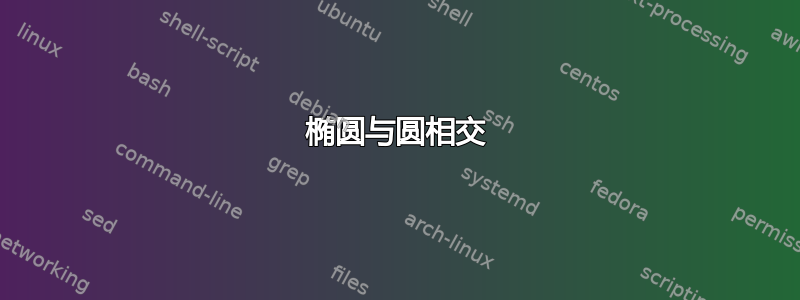
我正在尝试绘制一个与影响范围相交的椭圆,即围绕月球的虚线圆。椭圆需要沿矢量穿过(-170.864:.7cm)位置v0并相交于(3.56699,.25)。
从图中可以看出,我想要椭圆经过和的交点,r0然后在月球周围圆圈处的两条线的连线处相交。
v0v0
\documentclass{article}
\usepackage{tikz, pgfplots}
\begin{document}
\begin{tikzpicture}[line join = round, line cap = round, scale = 2,
>=triangle 45]
\draw (0,0) -- (4,0) node[scale = .45, fill = white] at (2,0) {$D$};
\draw (0,0) -- (-45:4cm);
\begin{scope}[decoration = {markings,
mark = at position 0.5 with {\arrow{>}}, }]
\draw[postaction = decorate] (-45:4cm) arc (-45:0:4cm);
\end{scope}
\draw (0,0) -- (3.56699,.25) node[scale = .75, fill = white]
at (1.99511,.139831) {$r_1$};
\draw (0:2.25cm) arc (0:4.00914:2.25cm) node[scale = .75] at (1.7:2.4cm) {$\gamma_1$};
\begin{scope}[xshift = 4cm]
\draw (0,0) -- (150:.5cm);
\draw (-.2,0) arc (180:150:.2cm);
\node[scale = .75] at (165:.3cm) {$\lambda$};
\end{scope}
\begin{scope}[rotate around = {-80.864: (0,0)}]
\draw[-latex] (0,0) -- (0,-.7) node[left, scale = .75, fill = white, inner sep = .01cm] at (0,-.25) {$\mathbf{r}_0$};
\draw[-latex] (0,-.7) -- (1,-.7) node[left, scale = .75]
at (.4,-.7) {$\mathbf{v}_0$};
\end{scope}
\draw[dashed] (4,0) circle (.5cm);
\draw[dashed] (0,0) circle (.7cm);
\draw (-170.864:.4cm) arc (-170.864:0:.4cm) node[scale = .75,
fill = white, inner sep = .01cm] at (-85:.4cm) {$\nu_1$};
\path (4,0) node {\includegraphics[width = .3cm]{moon.png}};
\path (0,0) node {\includegraphics[width = .6cm]{earth.png}};
\path (-45:4cm) node {\includegraphics[width = .3cm]{moon.png}};
\end{tikzpicture}
\end{document}
答案1
因此,我很幸运,旋转正好穿过了影响范围点。

\begin{center}
\begin{tikzpicture}[line join = round, line cap = round, scale = 2,
>=triangle 45]
\draw (-170.864:.3cm) arc (-170.864:0:.3cm) node[scale = .75,
fill = white, inner sep = .01cm] at (-85:.3cm) {$\nu_1$};
\draw (-170.864:.5cm) arc (-170.864:-28.996:.5cm) node[scale = .75,
fill = white, inner sep = .01cm] at (-90:.5cm) {$\gamma_0$};
\draw (0,0) -- (4,0) node[scale = .45, fill = white] at (2,0) {$D$};
\draw (0,0) -- (-28.966:4cm);
\begin{scope}[decoration = {markings,
mark = at position 0.5 with {\arrow{>}}, }]
\draw[postaction = decorate] (-28.966:4cm) arc (-28.966:0:4cm);
\end{scope}
\draw (0,0) -- (3.56699,.25) node[scale = .75, fill = white]
at (1.99511,.139831) {$r_1$};
\draw (0:2.25cm) arc (0:4.00914:2.25cm) node[scale = .75] at (1.7:2.4cm)
{$\gamma_1$};
\begin{scope}[xshift = 4cm]
\draw (0,0) -- (150:.5cm);
\draw (-.2,0) arc (180:150:.2cm);
\node[scale = .75] at (165:.3cm) {$\lambda$};
\end{scope}
\begin{scope}[rotate around = {-80.864: (0,0)}]
\draw[-latex] (0,0) -- (0,-.7) node[left, scale = .75, fill = white,
inner sep = .01cm] at (0,-.25) {$\mathbf{r}_0$};
\draw[-latex] (0,-.7) -- (1,-.7) node[left, scale = .75]
at (.4,-.7) {$\mathbf{v}_0$};
\end{scope}
\draw[dashed] (4,0) circle (.5cm);
\draw[dashed] (0,0) circle (.7cm);
\path (4,0) node {\includegraphics[width = .3cm]{moon.png}};
\path (0,0) node {\includegraphics[width = .6cm]{earth.png}};
\path (-28.996:4cm) node {\includegraphics[width = .3cm]{moon.png}};
\begin{scope}[rotate around = {15: (-170.864:.7cm)}]
\clip (-0.69112,-0.111145) -- (3.48,.25) -- (3.5,-1) --
(-0.69112,-2) -- cycle;
\draw (-170.864:.7cm) arc (-170.864:189.136:3cm and 1cm);
\end{scope}
\begin{scope}[rotate around = {15: (-170.864:.7cm)}]
\draw[dashed] (-170.864:.7cm) arc (-170.864:189.136:3cm and 1cm);
\end{scope}
\end{tikzpicture}
编辑:
因此,我找到了一种使用圆弧构造椭圆截面的方法,而不必像上面那样随意绘制。
\documentclass[convert = false]{standalone}
\usepackage{tikz}
\usetikzlibrary{arrows}
\usetikzlibrary{calc}
\usetikzlibrary{decorations.markings}
\usetikzlibrary{intersections}
\usetikzlibrary{backgrounds}
\tikzset{
partial circle/.style args = {#1:#2:#3}{
insert path = {+ (#1:#3) arc (#1:#2:#3)}
}
}
\begin{document}
\begin{tikzpicture}[line join = round, line cap = round, >=triangle 45,
every label/.append style = {font = \tiny},
dot/.style = {inner sep = 0pt, shape = circle,
draw = black, label = {#1}},
small dot/.style = {minimum size = .05cm, dot = {#1}},
big dot/.style = {minimum size = .1cm, dot = {#1}},
]
\def\d{6}
\def\moonrad{.2}
\def\earthrad{.5}
\def\msoi{1}
\coordinate (O) at (0, 0);
\coordinate (Mi) at (-45:\d);
\coordinate (Mf) at (0:\d);
\begin{scope}[decoration = {markings,
mark = at position 0.32 with {\arrow{latex}}
}]
\draw[postaction = decorate] (O) [partial circle = -60:60:\d];
\end{scope}
\draw (O) -- (Mi);
\draw (O) -- (Mf) node[pos = .5, inner sep = 0, fill = white, font = \tiny]
{D};
\draw[-latex] (O) -- (-135:1.5cm) coordinate (r0)node[left, pos = .7,
font = \tiny] {\(\mathbf{r}_0\)};
\path[rotate = {209.5}, name path global = ell] (r0) arc[x radius = 4.5cm,
y radius = 1.75cm, start angle = 0, end angle = 160];
\foreach \position/\i in {Mi/1, Mf/2}{
\draw[red, name path global/.expanded = circ\i] (\position)
circle[radius = \msoi];
}
\node[coordinate, name intersections = {of = circ2 and ell}] (P1) at
($(intersection-2)$) {};
\begin{pgfonlayer}{background}
\begin{scope}[decoration = {markings,
mark = between positions .1 and 1 step .15 with {\arrow{latex}},
}]
\begin{pgfinterruptboundingbox}
\clip (P1) rectangle ($(r0) + (-1, -2)$);
\end{pgfinterruptboundingbox}
\draw[postaction = decorate, rotate = {209.5}, name path global = ell]
(r0) arc[x radius = 4.5cm, y radius = 1.75cm, start angle = 0,
end angle = 160];
\end{scope}
\end{pgfonlayer}
\draw[-latex] (O) -- (P1) node[font = \tiny, inner sep = 0, fill = white,
pos = .5] {\(\mathbf{r}_1\)};
\draw[-latex] (Mf) -- (P1) node[font = \tiny, pos = .6, right, fill = white,
inner sep = 0] {\(R_{soi}\)};
\shade[outer color = gray!70!blue!50, inner color = black!30!blue!90]
(Mi) circle[radius = \moonrad];
\shade[outer color = gray!70!blue!50, inner color = black!30!blue!90]
(Mf) circle[radius = \moonrad];
\shade[outer color = green!70!blue!50, inner color = black!30!green!90]
(O) circle[radius = \earthrad];
\draw[-latex] let
\p0 = (O),
\p1 = (r0),
\p2 = (Mi),
\n1 = {atan2(\x1 - \x0, \y1 - \y0)},
\n2 = {atan2(\x2 - \x0, \y2 - \y0)},
\n3 = {1cm},
\n4 = {(\n1 + \n2) / 2}
in (O) +(\n1:\n3) arc[radius = \n3, start angle = \n1, end angle = \n2]
node[fill = white, inner sep = 0, font = \tiny] at ([shift = (O)] \n4:\n3)
{\(\nu_0\)};
\draw[-latex] let
\p0 = (O),
\p1 = (Mf),
\p2 = (P1),
\n1 = {atan2(\x1 - \x0, \y1 - \y0)},
\n2 = {atan2(\x2 - \x0, \y2 - \y0)},
\n3 = {2cm},
\n4 = {(\n1 + \n2) / 2}
in (O) +(\n1:\n3) arc[radius = \n3, start angle = \n1, end angle = \n2]
node[fill = white, inner sep = 0, font = \tiny] at ([shift = (O)] \n4:2.2cm)
{\(\nu_1\)};
\draw[-latex] let
\p0 = (Mf),
\p1 = (O),
\p2 = (P1),
\n1 = {atan2(\x1 - \x0, \y1 - \y0)},
\n2 = {atan2(\x2 - \x0, \y2 - \y0)},
\n3 = {.7cm},
\n4 = {(\n1 + \n2) / 2}
in (Mf) +(\n1:\n3) arc[radius = \n3, start angle = \n1, end angle = \n2]
node[fill = white, inner sep = 0, font = \tiny] at ([shift = (Mf)] \n4:\n3)
{\(\lambda_1\)};
\end{tikzpicture}
\end{document}



